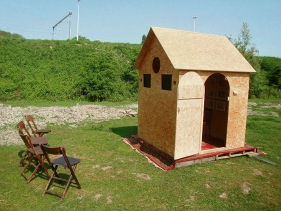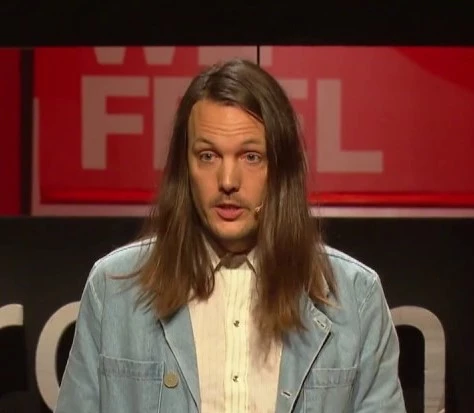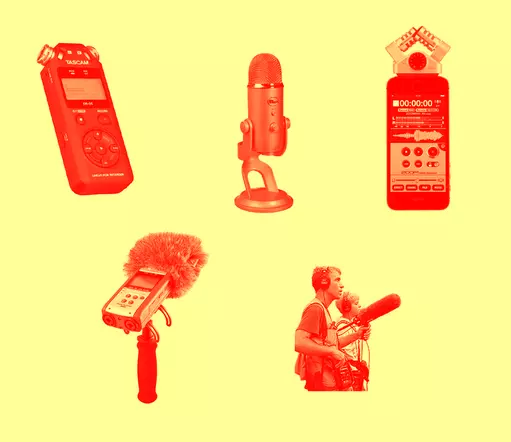
LectureThijs van Vuure: What is it like to be a bird?
What is it like to be a bird?
28 feb. 2019 ArtEZ Arnhem, Collegezaal (M3.07)
(archive)
In a small birdhouse, birdsong is slowed down to human speed, mimicked and sped back up to a bird’s pace, allowing visitors to sing like a bird. In his project ‘What is it like to be a bird?’ Thijs van Vuure combines his interests in science, art, and philosophy, and he tries to generate questions and answers from this interdisciplinary perspective. Ever since he was a child, artist Thijs van Vuure has been fascinated by birds. The project is an attempt to blur the boundaries between human-being and bird-being and a study of the consciousness of birds from a human perspective.
Thijs van Vuure studied biology and philosophy at the Vrije Universiteit, Amsterdam. After his master’s degree, he studied instrumental performance and music composition at the Hogeschool voor de Kunsten, Utrecht, and at the Rietveld Academy, Amsterdam. Besides projects like What it is to be a bird? he also make site responsive performances as a part of Collectief Walden, an interdisciplinary collective with which he performs nationally and internationally (Oerol Festival, Kröller-Müller Museum, Lieux Publics, France and Turnhout, Belgium). Furthermore, he composes music for theater and play live in several formations. For an example, visit the website of HIT ME TV.
www.thijsvanvuure.nl
5 Amazing ways to help clean and heal your Chakra
In March 150 first and second year students from ArtEZ University of the Arts (music-theatre makers, actors, dancers, musicians and visual artists) come together for a week to exchange knowledge. The common goal – taking care of an evening-filling program for a public at the end of the week – serves as a stepping stone and catalyst for interdisciplinary cooperation.
The guest teachers Sascha van Riel (theatre set and lighting designer), Rosell Heijmen and Jessica Helbach (the last two form the art collective Suze May Sho) have based their professional practices on embracing interdisciplinary collaboration. Convinced of the usefulness of non-disciplinary knowledge, they want to add an extra layer to the mix of students and disciplines disguised as a theme: ‘5 Amazing ways to help clean and heal your Chakra’ is both a serious invitation to the students to relate to rituals, silence and meaning and leaves enough room for resistance. By means of sound, text, sense of touch and image, students will give shape to new rituals for themselves, each other and the spectator in 15 minutes performances to presented on March 15 (more information soon).
Thijs van Vuure studied biology and philosophy at the Vrije Universiteit, Amsterdam. After his master’s degree, he studied instrumental performance and music composition at the Hogeschool voor de Kunsten, Utrecht, and at the Rietveld Academy, Amsterdam. Besides projects like What it is to be a bird? he also make site responsive performances as a part of Collectief Walden, an interdisciplinary collective with which he performs nationally and internationally (Oerol Festival, Kröller-Müller Museum, Lieux Publics, France and Turnhout, Belgium). Furthermore, he composes music for theater and play live in several formations. For an example, visit the website of HIT ME TV.
www.thijsvanvuure.nl
5 Amazing ways to help clean and heal your Chakra
In March 150 first and second year students from ArtEZ University of the Arts (music-theatre makers, actors, dancers, musicians and visual artists) come together for a week to exchange knowledge. The common goal – taking care of an evening-filling program for a public at the end of the week – serves as a stepping stone and catalyst for interdisciplinary cooperation.
The guest teachers Sascha van Riel (theatre set and lighting designer), Rosell Heijmen and Jessica Helbach (the last two form the art collective Suze May Sho) have based their professional practices on embracing interdisciplinary collaboration. Convinced of the usefulness of non-disciplinary knowledge, they want to add an extra layer to the mix of students and disciplines disguised as a theme: ‘5 Amazing ways to help clean and heal your Chakra’ is both a serious invitation to the students to relate to rituals, silence and meaning and leaves enough room for resistance. By means of sound, text, sense of touch and image, students will give shape to new rituals for themselves, each other and the spectator in 15 minutes performances to presented on March 15 (more information soon).
related content

Thijs van Vuure
more in this series:
11 sep. 2019 -
Opening New Academic Year: Hidden Histories
26 mrt. 2019 -

